Case Study: Urinary Incontinence, Cystocele and Related Conditions
VerifiedAdded on 2022/08/12
|5
|899
|13
Case Study
AI Summary
This case study presents an overview of urinary incontinence and cystocele, common conditions often affecting women. The study defines key terms such as dehydration, electrolyte imbalance, and acid-base balance, providing a table of terms and their relation to imbalances like hypernatremia, hyponatremia, hyperkalemia, and hypokalemia. It differentiates between acidosis and alkalosis, including respiratory and metabolic variations. The case study focuses on Mrs. Meriwether, who is experiencing urinary incontinence and cystocele, potentially stemming from shoulder dystocia during childbirth. It also discusses different types of vaginal discharge, and the possibility of related conditions like gastroenteritis and renal lithiasis. The study is supported by references to relevant research papers.
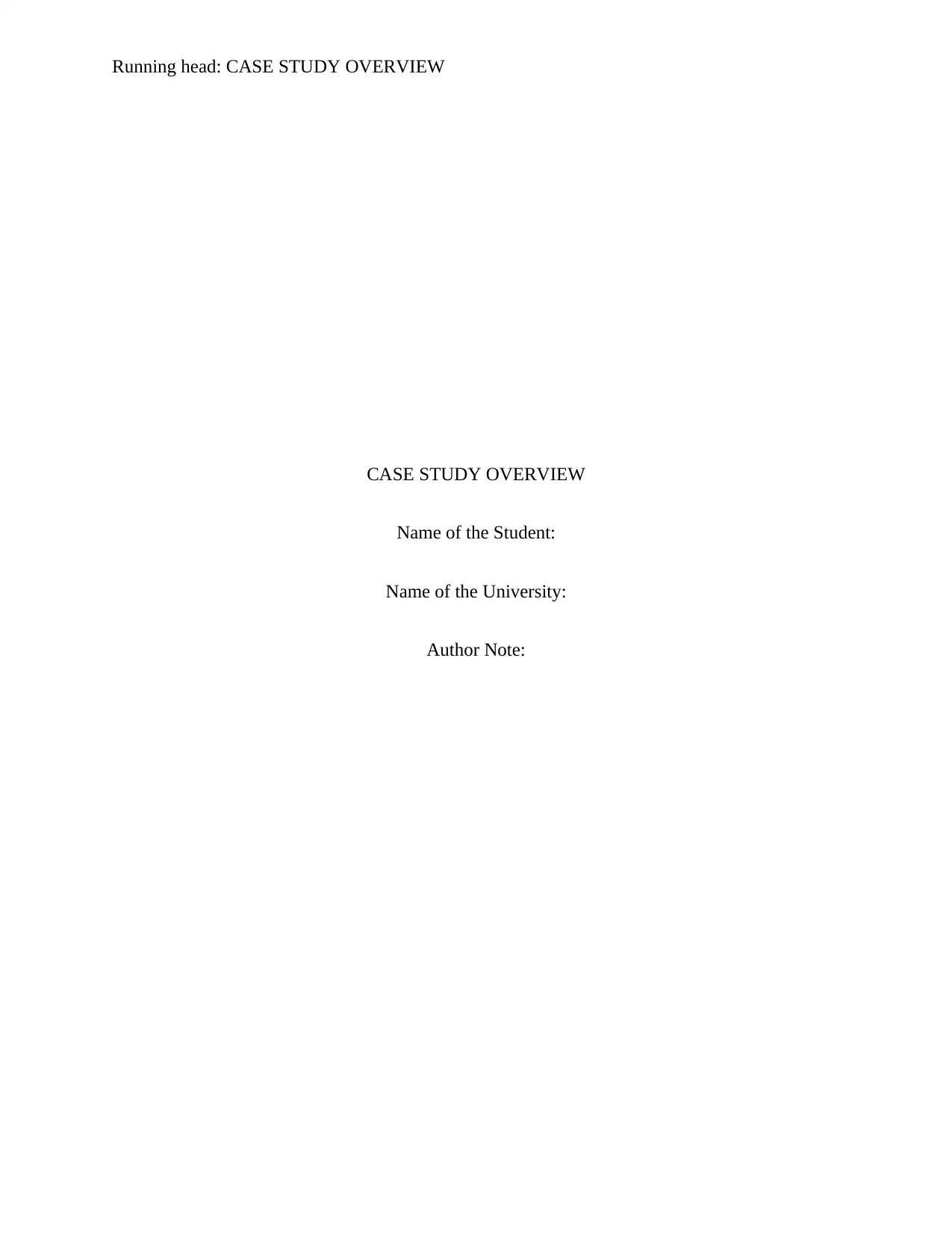
Running head: CASE STUDY OVERVIEW
CASE STUDY OVERVIEW
Name of the Student:
Name of the University:
Author Note:
CASE STUDY OVERVIEW
Name of the Student:
Name of the University:
Author Note:
Paraphrase This Document
Need a fresh take? Get an instant paraphrase of this document with our AI Paraphraser
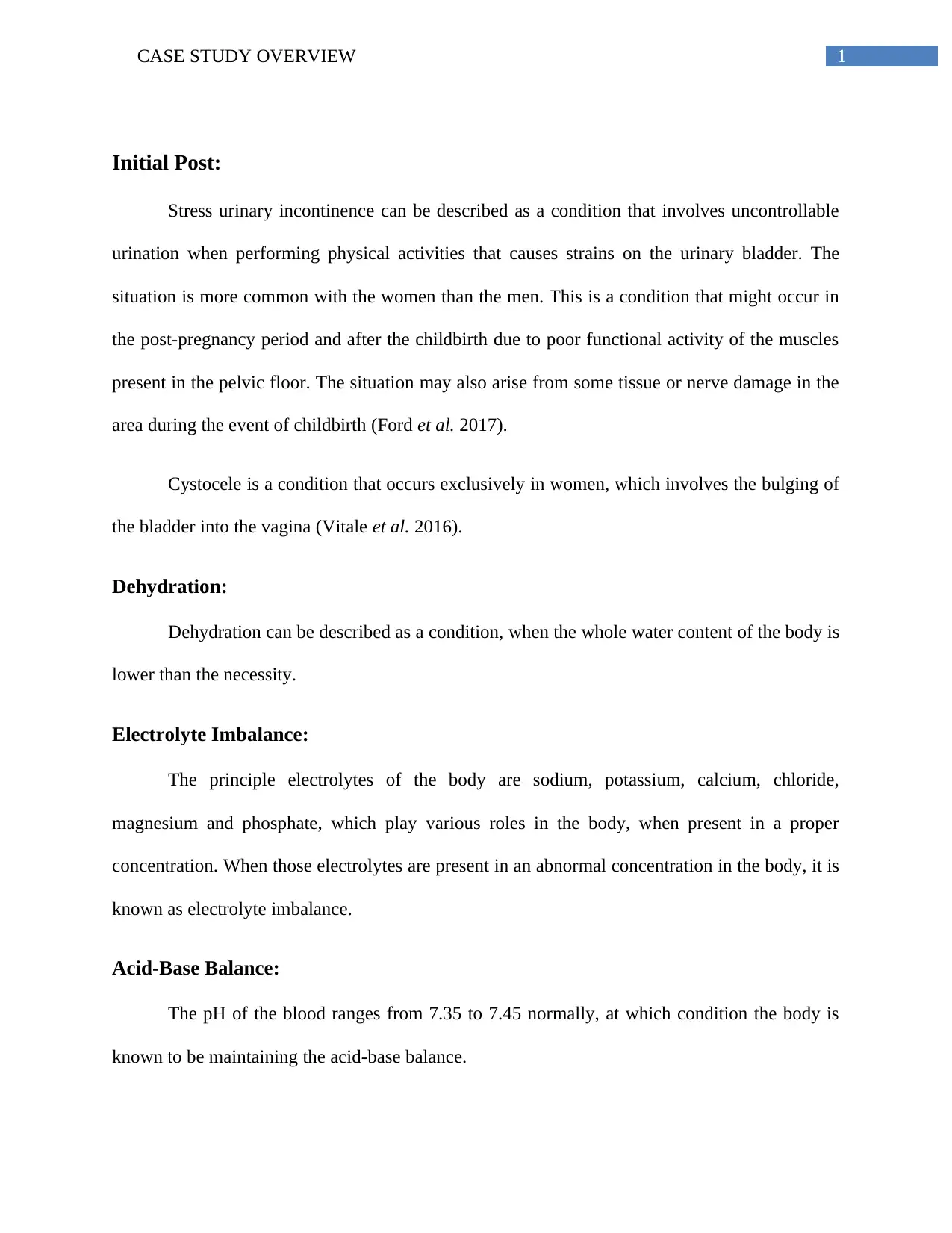
1CASE STUDY OVERVIEW
Initial Post:
Stress urinary incontinence can be described as a condition that involves uncontrollable
urination when performing physical activities that causes strains on the urinary bladder. The
situation is more common with the women than the men. This is a condition that might occur in
the post-pregnancy period and after the childbirth due to poor functional activity of the muscles
present in the pelvic floor. The situation may also arise from some tissue or nerve damage in the
area during the event of childbirth (Ford et al. 2017).
Cystocele is a condition that occurs exclusively in women, which involves the bulging of
the bladder into the vagina (Vitale et al. 2016).
Dehydration:
Dehydration can be described as a condition, when the whole water content of the body is
lower than the necessity.
Electrolyte Imbalance:
The principle electrolytes of the body are sodium, potassium, calcium, chloride,
magnesium and phosphate, which play various roles in the body, when present in a proper
concentration. When those electrolytes are present in an abnormal concentration in the body, it is
known as electrolyte imbalance.
Acid-Base Balance:
The pH of the blood ranges from 7.35 to 7.45 normally, at which condition the body is
known to be maintaining the acid-base balance.
Initial Post:
Stress urinary incontinence can be described as a condition that involves uncontrollable
urination when performing physical activities that causes strains on the urinary bladder. The
situation is more common with the women than the men. This is a condition that might occur in
the post-pregnancy period and after the childbirth due to poor functional activity of the muscles
present in the pelvic floor. The situation may also arise from some tissue or nerve damage in the
area during the event of childbirth (Ford et al. 2017).
Cystocele is a condition that occurs exclusively in women, which involves the bulging of
the bladder into the vagina (Vitale et al. 2016).
Dehydration:
Dehydration can be described as a condition, when the whole water content of the body is
lower than the necessity.
Electrolyte Imbalance:
The principle electrolytes of the body are sodium, potassium, calcium, chloride,
magnesium and phosphate, which play various roles in the body, when present in a proper
concentration. When those electrolytes are present in an abnormal concentration in the body, it is
known as electrolyte imbalance.
Acid-Base Balance:
The pH of the blood ranges from 7.35 to 7.45 normally, at which condition the body is
known to be maintaining the acid-base balance.
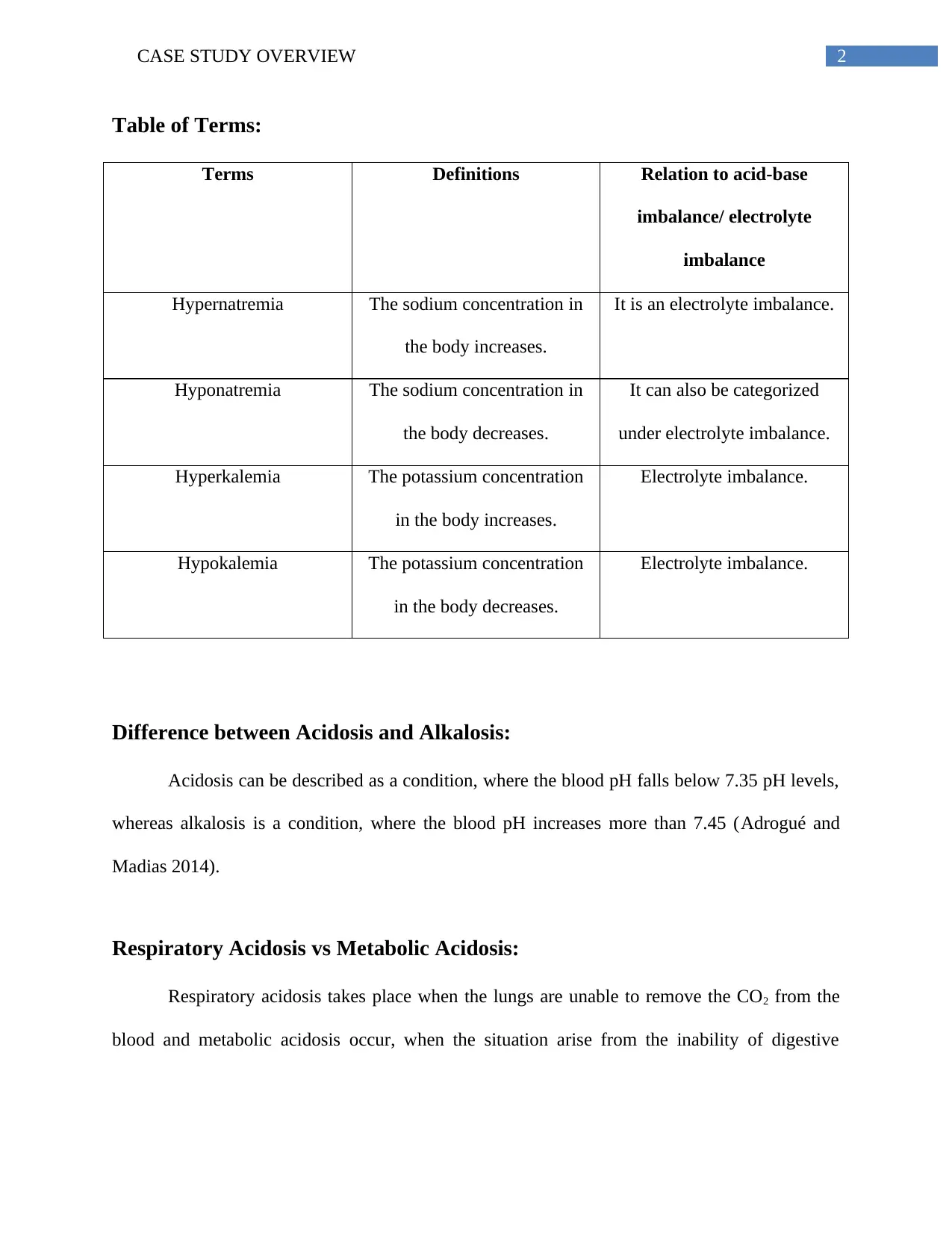
2CASE STUDY OVERVIEW
Table of Terms:
Terms Definitions Relation to acid-base
imbalance/ electrolyte
imbalance
Hypernatremia The sodium concentration in
the body increases.
It is an electrolyte imbalance.
Hyponatremia The sodium concentration in
the body decreases.
It can also be categorized
under electrolyte imbalance.
Hyperkalemia The potassium concentration
in the body increases.
Electrolyte imbalance.
Hypokalemia The potassium concentration
in the body decreases.
Electrolyte imbalance.
Difference between Acidosis and Alkalosis:
Acidosis can be described as a condition, where the blood pH falls below 7.35 pH levels,
whereas alkalosis is a condition, where the blood pH increases more than 7.45 (Adrogué and
Madias 2014).
Respiratory Acidosis vs Metabolic Acidosis:
Respiratory acidosis takes place when the lungs are unable to remove the CO2 from the
blood and metabolic acidosis occur, when the situation arise from the inability of digestive
Table of Terms:
Terms Definitions Relation to acid-base
imbalance/ electrolyte
imbalance
Hypernatremia The sodium concentration in
the body increases.
It is an electrolyte imbalance.
Hyponatremia The sodium concentration in
the body decreases.
It can also be categorized
under electrolyte imbalance.
Hyperkalemia The potassium concentration
in the body increases.
Electrolyte imbalance.
Hypokalemia The potassium concentration
in the body decreases.
Electrolyte imbalance.
Difference between Acidosis and Alkalosis:
Acidosis can be described as a condition, where the blood pH falls below 7.35 pH levels,
whereas alkalosis is a condition, where the blood pH increases more than 7.45 (Adrogué and
Madias 2014).
Respiratory Acidosis vs Metabolic Acidosis:
Respiratory acidosis takes place when the lungs are unable to remove the CO2 from the
blood and metabolic acidosis occur, when the situation arise from the inability of digestive
⊘ This is a preview!⊘
Do you want full access?
Subscribe today to unlock all pages.

Trusted by 1+ million students worldwide
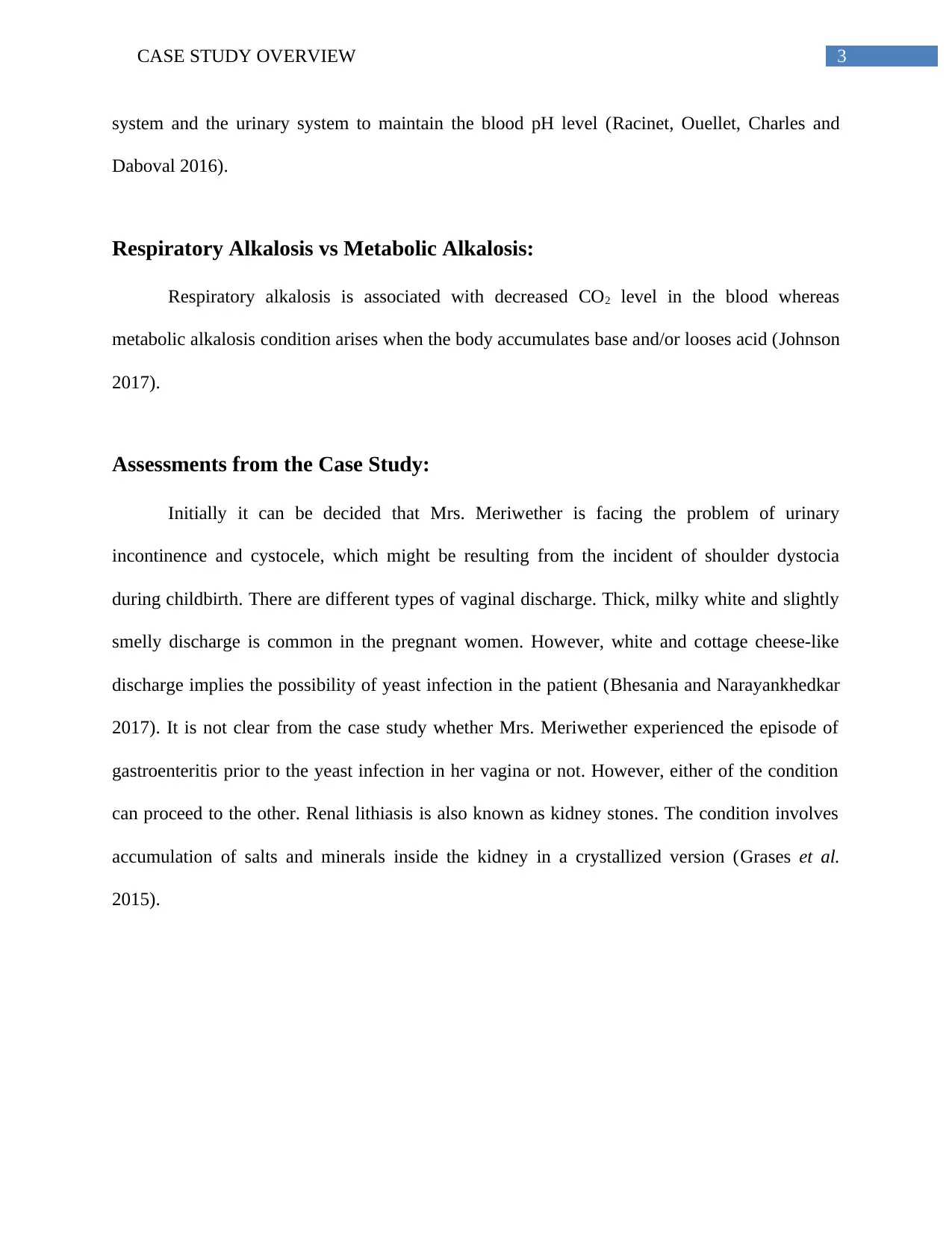
3CASE STUDY OVERVIEW
system and the urinary system to maintain the blood pH level (Racinet, Ouellet, Charles and
Daboval 2016).
Respiratory Alkalosis vs Metabolic Alkalosis:
Respiratory alkalosis is associated with decreased CO2 level in the blood whereas
metabolic alkalosis condition arises when the body accumulates base and/or looses acid (Johnson
2017).
Assessments from the Case Study:
Initially it can be decided that Mrs. Meriwether is facing the problem of urinary
incontinence and cystocele, which might be resulting from the incident of shoulder dystocia
during childbirth. There are different types of vaginal discharge. Thick, milky white and slightly
smelly discharge is common in the pregnant women. However, white and cottage cheese-like
discharge implies the possibility of yeast infection in the patient (Bhesania and Narayankhedkar
2017). It is not clear from the case study whether Mrs. Meriwether experienced the episode of
gastroenteritis prior to the yeast infection in her vagina or not. However, either of the condition
can proceed to the other. Renal lithiasis is also known as kidney stones. The condition involves
accumulation of salts and minerals inside the kidney in a crystallized version (Grases et al.
2015).
system and the urinary system to maintain the blood pH level (Racinet, Ouellet, Charles and
Daboval 2016).
Respiratory Alkalosis vs Metabolic Alkalosis:
Respiratory alkalosis is associated with decreased CO2 level in the blood whereas
metabolic alkalosis condition arises when the body accumulates base and/or looses acid (Johnson
2017).
Assessments from the Case Study:
Initially it can be decided that Mrs. Meriwether is facing the problem of urinary
incontinence and cystocele, which might be resulting from the incident of shoulder dystocia
during childbirth. There are different types of vaginal discharge. Thick, milky white and slightly
smelly discharge is common in the pregnant women. However, white and cottage cheese-like
discharge implies the possibility of yeast infection in the patient (Bhesania and Narayankhedkar
2017). It is not clear from the case study whether Mrs. Meriwether experienced the episode of
gastroenteritis prior to the yeast infection in her vagina or not. However, either of the condition
can proceed to the other. Renal lithiasis is also known as kidney stones. The condition involves
accumulation of salts and minerals inside the kidney in a crystallized version (Grases et al.
2015).
Paraphrase This Document
Need a fresh take? Get an instant paraphrase of this document with our AI Paraphraser
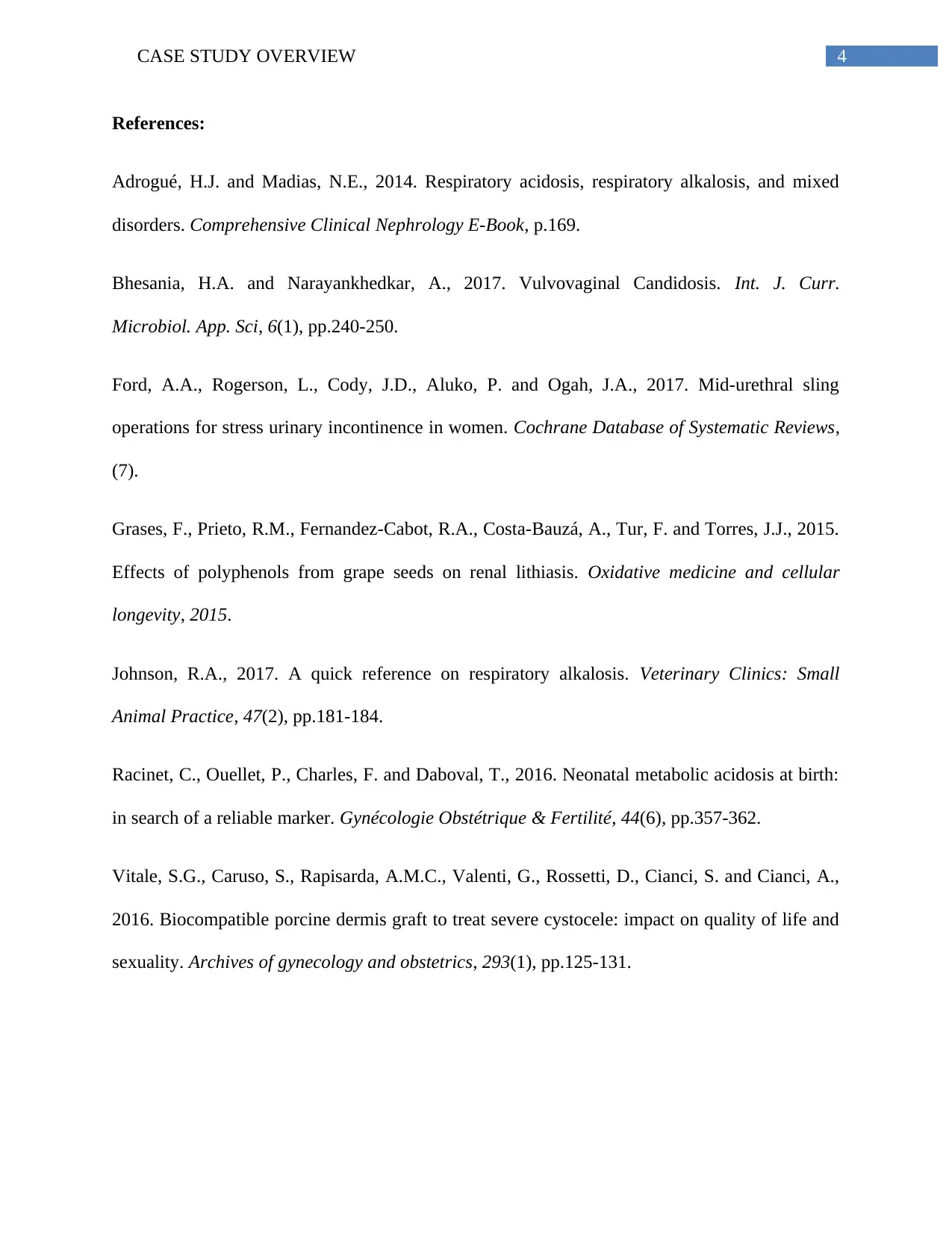
4CASE STUDY OVERVIEW
References:
Adrogué, H.J. and Madias, N.E., 2014. Respiratory acidosis, respiratory alkalosis, and mixed
disorders. Comprehensive Clinical Nephrology E-Book, p.169.
Bhesania, H.A. and Narayankhedkar, A., 2017. Vulvovaginal Candidosis. Int. J. Curr.
Microbiol. App. Sci, 6(1), pp.240-250.
Ford, A.A., Rogerson, L., Cody, J.D., Aluko, P. and Ogah, J.A., 2017. Mid‐urethral sling
operations for stress urinary incontinence in women. Cochrane Database of Systematic Reviews,
(7).
Grases, F., Prieto, R.M., Fernandez-Cabot, R.A., Costa-Bauzá, A., Tur, F. and Torres, J.J., 2015.
Effects of polyphenols from grape seeds on renal lithiasis. Oxidative medicine and cellular
longevity, 2015.
Johnson, R.A., 2017. A quick reference on respiratory alkalosis. Veterinary Clinics: Small
Animal Practice, 47(2), pp.181-184.
Racinet, C., Ouellet, P., Charles, F. and Daboval, T., 2016. Neonatal metabolic acidosis at birth:
in search of a reliable marker. Gynécologie Obstétrique & Fertilité, 44(6), pp.357-362.
Vitale, S.G., Caruso, S., Rapisarda, A.M.C., Valenti, G., Rossetti, D., Cianci, S. and Cianci, A.,
2016. Biocompatible porcine dermis graft to treat severe cystocele: impact on quality of life and
sexuality. Archives of gynecology and obstetrics, 293(1), pp.125-131.
References:
Adrogué, H.J. and Madias, N.E., 2014. Respiratory acidosis, respiratory alkalosis, and mixed
disorders. Comprehensive Clinical Nephrology E-Book, p.169.
Bhesania, H.A. and Narayankhedkar, A., 2017. Vulvovaginal Candidosis. Int. J. Curr.
Microbiol. App. Sci, 6(1), pp.240-250.
Ford, A.A., Rogerson, L., Cody, J.D., Aluko, P. and Ogah, J.A., 2017. Mid‐urethral sling
operations for stress urinary incontinence in women. Cochrane Database of Systematic Reviews,
(7).
Grases, F., Prieto, R.M., Fernandez-Cabot, R.A., Costa-Bauzá, A., Tur, F. and Torres, J.J., 2015.
Effects of polyphenols from grape seeds on renal lithiasis. Oxidative medicine and cellular
longevity, 2015.
Johnson, R.A., 2017. A quick reference on respiratory alkalosis. Veterinary Clinics: Small
Animal Practice, 47(2), pp.181-184.
Racinet, C., Ouellet, P., Charles, F. and Daboval, T., 2016. Neonatal metabolic acidosis at birth:
in search of a reliable marker. Gynécologie Obstétrique & Fertilité, 44(6), pp.357-362.
Vitale, S.G., Caruso, S., Rapisarda, A.M.C., Valenti, G., Rossetti, D., Cianci, S. and Cianci, A.,
2016. Biocompatible porcine dermis graft to treat severe cystocele: impact on quality of life and
sexuality. Archives of gynecology and obstetrics, 293(1), pp.125-131.
1 out of 5
Related Documents
Your All-in-One AI-Powered Toolkit for Academic Success.
+13062052269
info@desklib.com
Available 24*7 on WhatsApp / Email
![[object Object]](/_next/static/media/star-bottom.7253800d.svg)
Unlock your academic potential
Copyright © 2020–2025 A2Z Services. All Rights Reserved. Developed and managed by ZUCOL.





